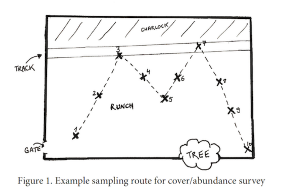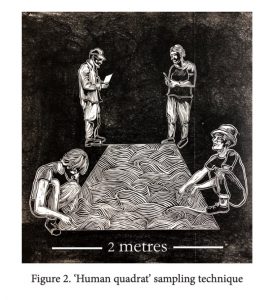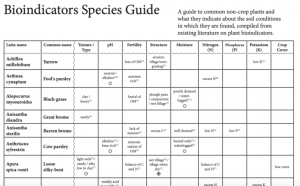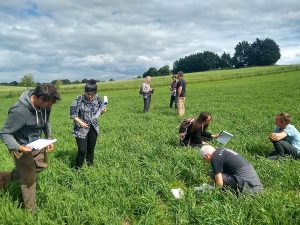What is a weed? We generally think of it as a ‘plant in the wrong place’. But what if we viewed these plants as signs of the ecology in which they are embedded? In this blog, Chris Maughan discusses a recent participatory study exploring the use of ‘plant bioindicators’ by UK farmers, and the publication of a new Bioindicator Field Guide. Underlying this are questions of how compatible are plant bioindicators as part of a farmer-centred, agroecological approach to soil management? And how likely are farmers to start using them as a way to engage more deeply with land they steward?
What are ‘plant bioindicators’?
We are often told that soils are a vital resource, that they are being lost at alarming rates, and that farmers and land managers should do more to halt their degradation. But how is this to be done? Often we are told this by scientists who have access to expensive equipment and who have time and specialist knowledge to sample soils and analyse them. But what if there was another way that didn’t involve even looking underground, let alone relying on labs and expensive soil consultants?
It was questions like that that were being explored during a meeting last year between representatives of the Landworkers’ Alliance, CAWR and the Organic Research Centre. Each of us had some experience of using accessible, non-lab-based soil tests. So we were very much intrigued when Rupert Dunn (then of the LWA and Peasant Bakery Torth y Tir) came across an apparently magical book – an encyclopedia of ‘plant bioindicators’ – which had cataloged over 800 wildflower species and what they indicated about soil conditions.
In short, we were keen to explore if plant bioindicators – defined as any plant used as a proxy for ecosystem condition – could provide an accessible and convenient way for farmers and growers to conduct soil assessments. The only problem was that the book, by botanist Gerard Ducerf, was in French. Not insurmountable in itself, but given the place-specificity of plant ‘ecotypes’ (i.e. subspecies adapted to local environmental conditions) we could see the limitations of using a study like Ducerf’s in UK agro-ecosystems. While we found a few more sources, only one was specific to the UK, and even that wasn’t specifically intended as a bioindicator resource.
What did we want to find out?
Would it be possible, we wondered, to begin a process similar to the one Ducerf had undertaken here in the UK? In other words, to begin building regionally-specific plant bioindicator knowledge? Moreover, could this work be done in a participatory way, working with farmers to explore existing knowledge and shape a methodology tailored to their particular interests and capacities?
In early spring 2021 we hastily started planning a series of field walks designed to iteratively develop a plant bioindicator methodology, building on Ducerf’s work. We were acutely aware of the lack of research on the topic (especially in the UK); as such we also intended to compare what we found with conventional soil tests. In other words: did the plants we observed aboveground accurately reflect soil conditions underground?
We approached three organic arable farms to host the walks – Gothelney Farm in Somerset; Torth y Tir in Pembrokeshire; and Green Acres Farm in Shropshire. Arable, so as to make comparison easier, but also organic given the system’s vulnerability to high weed burdens, combined with its limited options for weed control.
What happened?
With all this in mind, our field walks began with a simplified botanical survey, identifying as many plants in the chosen field to build up a picture of the diversity there. We then did a field walk (or ‘transect’), tracing a ‘W’ over the field (see illustration below), stopping at ten equidistant locations to identify all plants and estimate their percentage cover.

What we were aiming for was a simple but rigorous way to estimate the percentage cover of the weed species encountered during the field walk. In other words, to control for biases which might lead us to notice one weed in one part of the field, or not notice others.
Each time we ran the workshop we added something new to the process. For example, we consolidated the scoring system, which began simply as a way to prompt discussion, but by the final session had evolved into a stepwise method for identifying ‘weed communities’; that is, groups of species which prefer the same conditions or niches. With this approach the intention was to enable participants to move away from seeing individual species in isolation, to seeing the bigger picture of the botanical community as a whole.
We also introduced the idea of the ‘human quadrat’ (illustrated below), a technique for speeding up cover/abundance estimates while maximising shared learning and deliberation. Finally, we put a growing emphasis on making time to share food and conversation, as a way to foreground the importance of peer connections and future relationships.

What did we find?
Above all, we found that there is an incredible amount of interest in this topic. The first three field walks were booked up in a matter of weeks, and more than fifty people turned up to the workshop at the Land Skills Fair. Encouragingly, it was clear that many were already using bioindicators and had a loose knowledge of their significance. Whether it was an awareness that broadleaf dock (Rumex obtusifolius) or couch grass (Elytrigia repens) might indicate compaction, or nettles (Urtica dioica) could be an indication of soil fertility, the underlying concept of bioindicators was a familiar one. That said, what was lacking perhaps was the rigor underlying this, as well as access to reliable information on the hundreds of other weed species common in farming systems – this is where we see scope for further study.
The method we started with (loosely adapted from Ducerf) needed updating and our iterative approach allowed us to see what worked and what didn’t. Much of this was simply about clarifying the steps and getting these written up, which we have now done in our Farmer’s Field Guide, beautifully illustrated by Pearl Moss Press. The Guide is very much a work in progress, so any feedback on its content or layout, and especially how it could be developed or improved going forward, is enthusiastically encouraged.

What happens next?
The fields we surveyed were ideal for introducing participants to plant identification and what we found there was powerful evidence of exemplary soil management, with one field yielding 36 individual species. But unfortunately this didn’t reveal much in the way of interesting soil ‘problems’. For best results, future activities should be targeted at known soil problems to be able to further test the scoring system and the reliability of the existing knowledge on plant bioindicators.
Unlike the enthusiasm and interest among participants, reliable knowledge on this is sparse. Much work lies ahead in building up regionally specific evidence for the preferred conditions of even our most common weeds. One option is perhaps to take a citizen science approach, simultaneously skilling up participants in plant identification and use of the method while also filling in gaps and deepening the evidence base as required.

Participants undertaking a botanical survey on the first ‘Bioindicators field walk’ at Gothelney Farm, Somerset, June 2021.
However we proceed, we very much consider the plant bioindicator method alongside a host of other tools for deepening our connection with land. Bioindicators are not (yet) a one-stop-shop for soil diagnostics. Instead, like many agroecological tools, they are part of a complex and long-term process of relationship building with our farms, soils, and plants that grow there – part of a journey towards a holistic rather than reductive approach to soil management.
We are still working out next steps, but please do get in contact if you’d like to know more or explore collaboration. We will also be running a one-off workshop on the Bioindicator method at Farm-ED in Oxfordshire on May 18th 2022. If you missed us the first time around, this is your chance to get a first hand experience of the approach – click here for more info.

